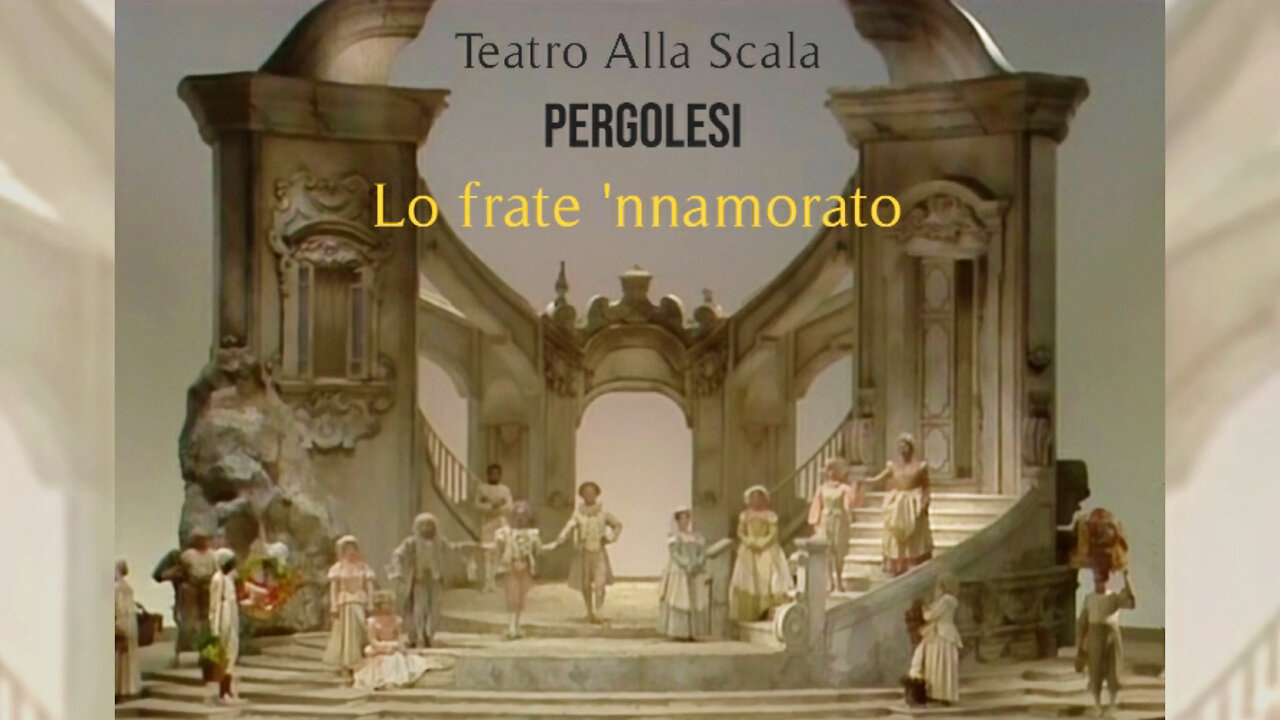Premium Only Content

Pergolesi: Lo frate 'nnamorato | Corbelli, Focile, Felle, di Nissa, D'Intino - Muti (La Scala 1989)
Title: Lo frate 'nnamorato (The Brother in Love)
Composer: Giovanni Battista Pergolesi
Libretto: Gennaro Antonio Federico
Premiere: 27 September 1732 (Teatro dei Fiorentini, Naples)
Language: Neapolitan and Italian
Subtitles: English, Russian (Click on CC for subtitles)
Enter the sparkling world of eighteenth-century commedia musicale! Giovanni Battista Pergolesi's "Lo Frate 'nnamorato" is a jewel of an opera, rediscovered and mounted by Riccardo Muti and the forces of La Scala to universal acclaim. A charming tale of mismatched lovers and rival suitors, the story provides a wealth of arias and ensemble pieces displaying an astonishing variety of melodies! This sumptuous production reflects the superb alliance of musical and artistic talent brought together to make this little-known baroque masterpiece a triumph of the stage.
Production: Teatro alla Scala di Milano
Orchestra & Chorus of Teatro alla Scala
Conductor: Riccardo Muti
Stage Director: Roberto De Simone
Set design: Mauro Carosi
Costumes: Odette Nicoletti
TV Director: John Michael Phillips
Rec. Live: 28 December 1989 (2nd Representation)
Cast & Characters:
Marcaniello: Alessandro Corbelli
Ascanio: Nuccia Focile
Nena: Amelia Felle
Nina: Bernadette Manca di Nissa
Luggrezia: Luciana D'Intino
Carlo: Ezio Di Cesare
Vanella: Elizabeth Norberg-Schulz
Cardella: Nicoletta Curiel
Don Pietro: Bruno De Simone
Lo schermidore: Luca Bonini
Lo frate 'nnamorato (Neapolitan: The Brother in Love) is a three-act commedia per musica (musical comedy, a form of opera buffa) by Giovanni Battista Pergolesi, to a Neapolitan libretto by Gennaro Antonio Federico, first performed in 1732.
At this time in history, when comic opera was in its infancy, librettists wrote works with both comic and serious characters. The opera, written when the composer was only 22, is his first attempt at comic opera. (It was followed in 1733 by his better-known short opera, La serva padrona). The first performance was on 27 September 1732, at the Teatro dei Fiorentini, Naples. A successful run was halted by a severe earthquake, which closed the theatres in Naples until the autumn of 1733. It was re-presented during the 1734 carnival season, in a version revised by the author.
Setting: House of Marcaniello; Capodimonte region of Naples
Ascanio, the brother of Nina and Nena, was stolen by brigands in childhood and presumed lost; he was, however, found and adopted by Marcaniello.
Now, Nina and Nena are the wards of their uncle, the Roman Don Carlo. Don Carlo wishes to marry Luggrezia, the daughter of Marcaniello, who himself wishes to marry Nina and to take Nena as a wife for his son, the foppish Don Pietro. Nina and Nena meanwhile have fallen in love with Ascanio, not realizing their relationship. The two maids Vanella (servant of Carlo) and Cardella (servant of Marcaniello) comment on and take part in the various intrigues which ensue.
Finally, in a duel with Carlo, the latter recognizes Ascanio as his lost nephew by a birthmark on his arm. Ascanio and Luggrezia are now free to marry.
-
 2:02:45
2:02:45
Adaneth - Arts & Literature
13 days agoGiordano: Andrea Chénier | Pavarotti, Guleghina, Pons - Levine, Joel (MET 1997-MULTISUB)
28 -
 LIVE
LIVE
Graham Allen
43 minutes agoDems PANIC as Shutdown Backfires! Fake News MELTS Down Over New Pentagon Press Corps!
4,971 watching -
 LIVE
LIVE
Wendy Bell Radio
4 hours agoWho Is Today's Democrat?
7,876 watching -
 LIVE
LIVE
Chad Prather
15 hours agoHow To Fight Back When The World Is Pulling You Apart!
3,950 watching -
 LIVE
LIVE
LFA TV
10 hours agoLIVE & BREAKING NEWS! | THURSDAY 10/23/25
5,614 watching -

Game On!
18 hours agoThursday Night Football NFL Week 8 Betting Preview: Vikings at Chargers!
8.03K1 -
 15:02
15:02
Demons Row
12 hours ago $1.49 earned8 Hardest Patches to Earn in 1% Motorcycle Club Culture 💀🏍️
25.4K6 -
 10:27
10:27
Adam Does Movies
21 hours ago $0.43 earnedShelby Oaks - Movie Review
9.42K7 -
 6:08
6:08
Blackstone Griddles
14 hours agoAlmost Famous French Toast on the Blackstone Camping Griddle
11.9K -
 LIVE
LIVE
BEK TV
23 hours agoTrent Loos in the Morning - 10/23/2025
159 watching